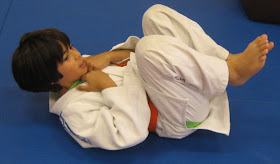"I know all 67 throws in the go kyu no waza."
is a brag I have heard rather often from a certain type. I have a confession to make:
- I don't know if it is actually spelled go kyu no waza.
- I don't know if there are actually 67 throws in it.
- I certainly don't know all of them.
Gasp! And I have a sixth-degree black belt! Yeah, I have a bunch of of good medals, too. How can that be. What a travesty!
I don't believe being a good judo player, or a good coach, is a matter of knowing every possible technique. In fact, think of the number of times you have seen a player hesitate in a match. For example, one player attempts a throw and misses because the opponent stepped out of the way or pushed the opponent down.
Both players hesitate and in the end nothing happens.
In a position like this, most people would probably try a sankaku time (also known as a triangle choke). I have no idea who the person is doing it in the video in that link but her sankaku looks pretty typical in that it takes a while to sink in.
I don't try sankaku from here for three reasons. First, I just don't do sankaku because for most of my judo career my right knee did not bend (I injured it seriously as a teenager). Second, even if I could do sankaku it probably would not be my technique of choice because so many people do it that your competitor is generally expecting it. The third reason is that it is just not the style of mat work that I do.
Here is what I do. First, as in the picture above, I get the hell out of the way so that she can't throw me. Notice I have stepped around her so that I am at her head and I am pushing down on her shoulder, putting my weight on her to stop her from trying to pop up and throw me.
Next, I am going to DIVE over her towards her hips at a 45-degree angle (and you thought there was no use for geometry in real life). If you aren't so good at geometry, look at the picture below.
Do NOT dive straight over or you will end up under your opponent, get pinned and look stupid. And I will say, "I told you so."
You are going to do a rolling break fall and as you do it you keep your right hand on the lapel, in the exact same grip it was from the time you started standing with a right lapel grip. This hand never moves. Just hold on to that grip for dear life.
Notice the movement in the picture below. You are sliding your hand under her arm and behind her head as you are rolling over her body NOT after you have completed the roll.
The picture below shows the position as the attacking player is in the middle of the roll. You can see that her right hand has hold of the lapel that is now pulled tight under the blue player’s neck. Her left hand is under the arm and moving behind the head.
Instead of continuing to a standing position as you would in a regular rolling break fall, you are going to slide back on to your stomach as shown below.
At this point, you are both choking your opponent and have her in a pin.
When I do drills starting from a particular position, like this one, I do the same couple of moves over and over. I don't have 67 different moves. I probably have a Plan A and a Plan B that I practice 1,000 times a year - EACH. Then I have a Plan C and a Plan D I practice about 500 times a year - EACH.
Because I do these so often, when I am in a particular position on the mat I am going to hit that move, say, the choke shown above, automatically, without thinking. If for some reason I cannot get it, say, the player turtles up too quickly and I cannot get the roll in fast enough, then I am going to go to my Plan B - automatically.
Tomorrow .... Plan B.
In the meantime ... Happy New Year !



















































